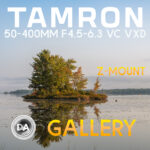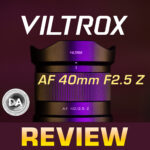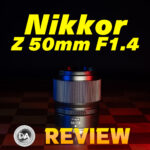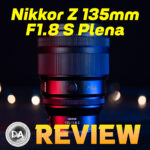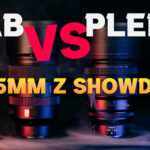
Tamron 50-400mm F4.5-6.3 VC VXD Z-Mount Review
In September of 2022 I had a chance to review the Sony E-mount version of Tamron’s very intriguing 50-400mm F4.5-6.3 VC VXD lens, a lens that expanded the traditional formula of a 100-400mm zoom by adding an additional 50mm of range on the wide end. That may not seem like a big deal initially, but it opens up all kinds of additional photography subjects and changes the zoom ratio from 4x to 8x! There are, of course, many lenses with an even larger zoom ratio, but those superzoom lenses are almost always compromised optically. I called that lens a “game changer”, and now it is coming to Nikon Z mount and adds a very compelling option for Nikon shooters. I have found that these Tamron zooms are better on Nikon than any other current platform, and I’ll detail why in both this text review and the video review linked below.
Follow Me @ YouTube | Patreon | Instagram | Facebook | DA Merchandise | Flickr | 500px | X
__________________________________________________________________________________________________
Thanks to Tamron USA for sending me a review copy of this lens. As always, this is a completely independent review. All opinions and conclusions are my own. *The tests and most of the photos that I share as a part of my review cycle have been done with the 45MP Nikon Z8, which I reviewed here.
__________________________________________________________________________________________________
The Tamron 50-400Z has an extremely impressive 8x zoom range, and goes from this at 50mm:

to this at 400mm:

That gives you a tremendous amount of versatility in framing your subject, and will make this lens a great option for landscape photography along with the more typical telephoto subjects.
Tamron likes complicated lens names, so let’s take a moment to unscramble what all those letters mean. Di-III refers to a lens that is purpose designed for mirrorless mounts, which, at the moment, is uniquely in the Sony full frame E-mount. It can also be used on APS-C E-mount cameras where the 1.5x crop factor gives a full frame equivalent focal range of 75-600mm. VC refers to Vibration Compensation, which is Tamron’s optical stabilization system, important in telephoto lenses to help deal with camera shake. Finally, VXD refers to the focus system, which is Tamron’s premium Voice-coil eXtreme-torque Drive, a high end linear focus motor system, which will allow you to capture fast moving action.

As we’ll see, the 50-400Z (as we’ll call it in this review to distinguish it from the E-mount version) follows in the trend of the 35-150mm by having a more premium build and feature set, but also comes at a higher price point than Tamron’s previous era 100-400mm lens, though fortunately the price for the Z-mount version is $1299, identical to the E-mount version. Some of Tamron’s lenses that have come to Z-mount have done so with a $100 price premium, but that’s not the case here.
*This will largely be a new review of a familiar lens, but there will be a few ingredients from my previous review of the E-mount where things are the same. I’ll also focus more on comparisons to what’s available on Z-mount.
Build and Handling
Tamron has managed to increase the zoom range without increasing the size and weight of the 50-400mm relative to most 100-400mm lenses, though, as per usual, the Z-mount version is necessarily a bit larger and heavier. The main reason for this is to accommodate the larger diameter of Nikon’s Z-mount relative to the Sony E-mount. The 50-400Z is 185.8mm (7.3″) in length compared to 183mm for the E-mount version. It remains 88.5mm in diameter despite the lens being wider at the lens mount for the simple reason that this isn’t the widest point on the lens. The weight increases a bit from 1155g to 1180g (41.6oz) in the Z-mount version. But both the size and the weight compare favorably to the Nikkor Z 100-400mm VR S-line lens, which is 98 x 222 mm and weighs 1435g:

There’s also the small matter of price! The Nikkor lens is currently only sale for $200 off in the US, and it still costs $2500 USD, which is near double the price of the Tamron lens. That’s one major vote in favor of the Tamron 50-400Z. All in all, it feels like Tamron has managed to keep the size and weight of the 50-400Z at nice levels while packing the lens with a lot of features.
The Tamron retains the 67mm filter thread that is shared by many of Tamron’s mirrorless offerings. This is great, as it will allow you to share filters with a wide variety of other lenses.

The 50-400Z has a relatively substantial feature list. It includes a custom/function button whose value can be set either in camera or via Tamron’s Lens Utility Software (more on that in a moment).

There’s also a bank with a couple of switches. This includes an AF | MF switch along with a secondary switch that allows access to multiple custom modes.

These custom modes can be programmed via the weather-sealed USB-C port on the side of the lens.

Simply attach the lens to your computer or Android device via USB-C and download Tamron’s free Lens Utility software (or Android app), and this opens up a variety of ways to customize the performance of your lens. Some of the potential functions include a preset A-B focus pulls, presetting a specific focus distance (like for an event), switching between focus and aperture for the focus ring, changing the speed and/or tension of the manual focus ring, and a new function in that you program a focus limiter function as well. This gives more options than just a focus limiter switch for those who rarely (or never) use just a focus limiter.



You can also do firmware updates through this software.
Tamron’s approach here does allow for a fair degree of customization, though some of the controls may be less obvious than just having a lot of labelled switches on the barrel. Nikon’s approach with the 100-400 S isn’t much different, however, with a lot of functions reserved to two custom buttons. That lens has a dedicated focus limiter in addition to an AF | MF switch, though Tamron perhaps a little advantage in that you can set the distance of the focus limiter. It’s not like the cheaper Tamron is radically outclassed in terms of features, however.
There is zoom lock switch to prevent zoom creep, though I didn’t actually encounter any real creep while out hiking with the lens. It only locks at the 50mm position.

Also present on the barrel is two rings. The closer and narrower of the two is the manual focus ring. It (like all mirrorless lenses) is focus-by-wire, meaning that focus input on the focus ring is routed through the focus motor to move the elements. The movement of the ring is smooth but a little light. I would prefer slightly more damping, but overall the quality of focus is fairly good. The addition of the USB-C port means that that you also have more control over the behavior of the focus ring. This includes being able to control the rotation of the ring and to choose whether the focus action is linear or non-linear (speed sensitive) in behavior. That just adds to the value of the ring.

The second ring is the zoom ring, which comes after a slight flare in the lens barrel which gives both a bit of style and the function of making the zoom ring slightly easier to find by feel. The zoom ring’s friction is very well damped. It has a smooth, substantial zoom action (not light, however) and the inner barrel extends about 75mm. The tolerances are tight, and there is no wobble or play in the barrel. Tamron notes that the zoom ring rotation arc is just 75° and allows for rapid zooming action.


Tamron has included a nicely made lens hood that surprisingly doesn’t have a locking button, though it could be argued it doesn’t need it. It bayonets into place very cleanly and helps provide some shading along with some bump protection. The lens hood has a nice bevel in the design that gives it more style than the typical slab of plastic. A look inside the hood shows more structure and reinforcement than many hoods, which should add up to more durability.

Tamron has worked to up their game in the physical appearance of their most recent lenses. The finish is a little glossier and (according to Tamron) has been upgraded to be more resistant to scratching and even fingerprints. The new finish makes the lens appear to be more like anodized metal, though I do think there’s still some engineered plastics in the construction. There’s a platinum-colored accept ring right near the lens mount. There is also some new sculpting to the lens design the gives it more shape. This does have some ergonomic value, as it makes the lens fit the hand a little better. It is worth noting that the lens does feel very good in the hands. Heavy, yes, but in a reassuringly substantial kind of way.

Tamron has really been nailing weather sealing, and that’s definitely the case here. There’s a rubber gasket at the lens mount that suggests at the weather sealing inside, and Tamron also shows a total of 8 other internal seal points (by my count) along with a fluorine coating on the front element to give further protection. A fluorine coating not only helps protect the front element from scratches but also makes it water and fingerprint resistant and thus easier to clean. This is a professional grade lens ready for professional use.


Tamron’s recent trends regarding MFD (minimum focus distance) hold true here, as the lens sports two different MFDs for wide (0.25m/9.8″) and telephoto (1.5m/59.1″). You can get to about 0.50x magnification on the wide end (1:2), which is as high as my Voigtländer 65mm F2 (classified as a macro lens) and 0.25x (1:4) on the telephoto end. Both figures are exceptionally good, which further extends the versatility of the 50-400Z. Here’s what maximum magnification looks like first at 50mm and then 400mm along with a real- world “macro” shot.



Both results are fairly good, with a little more contrast on the wide end but you can unlock creamier backgrounds on the long end and get a flatter plane of focus. Minimum focus distance will scale between these two extremes as you go throughout the zoom range. Add an extension tube and you’ve got true macro performance here.
Tamron has nine rounded blades in the aperture iris, and they claim that the aperture iris will stay circular for at least two stops down from maximum aperture, which seems accurate.
That high magnification figure and the ability to really compress backgrounds adds to the versatility of the lens. I’ve even used it for some product shots to capture details.

As noted, Tamron has included their VC (Vibration Compensation – Tamron’s optical stabilization system) on the 50-400Z. I’m often asked as to whether or not the VC system works in concert with the VR in Nikon cameras so equipped, and I don’t really know the answer. It is impossible to test as independent control of in camera VR is disabled when a lens with VC is attached. Turning off the VC on the lens also turns off IBIS, and vice versa. I do prefer the way that VR works on my Z8 relative to any of my Sony bodies, so overall I’m satisfied with the performance of the stabilization, as I feel like Nikon’s VR does a better job of augmenting telephoto lenses than Sony’s IBIS.
Tamron says this in their press release: “Furthermore, using AI technologies, the lens chooses the appropriate compensation characteristics for videography at focal lengths of 100mm or less.” If you read between the lines a bit, you’ll realize that you’ll get your best handheld video results at 100mm or less and you are better off with a tripod at longer focal lengths (which is a good rule of thumb in general), though as noted, that’s a little less true here on Nikon.
One area that may cause some controversy is that while the lens is fully designed around utilizing a tripod collar and foot, it is an optional accessory. The recommended tripod collar is the existing A035TM that was actually designed for the DSLR-era 100-400mm VC. I’ve used that collar, and it is nice (Arca-type compatible for quick use on a tripod), but it will cost an additional $130 USD if you don’t already have it. Tamron is betting that the lens is light enough to be handholdable for many people, but I know from my chart tests that a collar would definitely be valuable when working from a tripod.

Because of a Sony limitation on third party lenses not utilizing teleconverters, there is no TC option with the 50-400Z. The Tamron 50-400mm doesn’t even have physical room at the rear of the lens to fit a TC as the rear-most glass element is very close to the back of the lens at 50mm, though it does move forward when zoomed out to 400mm. This is one area where you might be compelled to spend the bigger money for the Nikkor lens.
Outside of a few quirks that I’ve detailed, the Tamron 50-400Z largely succeeds in the transition to Nikon Z mount. This is a nicely built, feature rich lens that feels premium while hugely undercutting the price of the Nikkor option.
Autofocus and Video
As noted earlier, the 50-400Z is equipped with Tamron’s premium VXD (Voice-coil Extreme-torque Drive) focus system. This provides very fast, quiet, and accurate focus results with a wide variety of subjects. Even at 400mm I was able to quickly acquire a bird on the wing and track it with ease though bursts of many dozens of shots.

I really enjoy the Z8 for tracking action. I can shoot up to 30FPS (though only JPEGs, as shown here), and I found tracking BIF to be fairly effortless. Whenever the eye becomes visible from behind the wing as the wings pump up and down, it is clear that focus has been accurate all along.






I’m loving these Tamron zooms on Z-mount where the third-party speed restrictions of Sony just don’t exist. These lenses no longer feel like second class citizens, and it’s a delight to fire well focused bursts.
Focus on eyes is precise and delivers great looking results.


I was able to focus precisely on other subjects as well, even when depth of field was paper thin.

Focus is essentially silent. Even while testing back and forth, back and forth, I heard only the sound of my finger on the shutter button. Focus speed is essentially instant at shorter focal lengths, with only a split second lag when making major focus changes on the telephoto end.
I likewise found that video focus was confident as well, with quick, confident focus changes that only occasionally showed a quick pulse in the process.
Overall I would say that focus has translated very well to Nikon, and when it comes to tracking sports or wildlife action, I would say it is, if anything, improved, particularly when you consider the lack of limitations on burst speed.
Image Quality Breakdown
Tamron has employed a rather complex optical design that consists of 24 elements in 18 groups. This includes a number of exotic elements as you can see in this optical diagram.

The MTF charts for the lens are tremendously impressive, with a near flawless result across the frame at 50mm even wide open and a similar result at 400mm.

It’s rare to see a zoom lens with such an impressive MTF performance, and this is a lens that definitely impresses in real world sharpness, too.

But we’ll take a closer look at optical performance, starting with vignette and distortion. All of the distortion throughout the zoom range is of the pincushion variety. I tend to prefer pincushion distortion (so long as it isn’t extreme) as it tends to be more linear and easier to correct for, which is the case here. Distortion is mildest at 50mm (-6 to manually correct), heaviest midrange at 200mm (-10), and very slightly reduced again at 400mm (-9).


As has been the case with all of lenses I’ve tested that come first to Sony and then to Nikon, vignette is significantly heavier on Z-mount. At 50mm I needed a +64 to correct vignette (vs +38 for Sony), which the bigger surprise came at 400mm, where I need a whopping +73 vs just a +27 on Sony. I suspect this has to do with the mount diameter being so much larger on Z-mount. Both figures are well within the range of being correctable by profiles in camera or software, however.
Longitudinal chromatic aberrations (LoCA) typically show up as purple/magenta fringing before the plane of focus and blue/green fringing beyond the plane of focus due to colors not being perfectly focused together. They typically diminish as the lens is stopped down to smaller apertures. I didn’t notice any issues with LoCA at all on the 50-400Z. Sun on these little white flowers showed no evidence of fringing.

Lateral chromatic aberrations (LaCA) show up as fringing on either side of contrast areas (like tree trunks, for example) along the edges of the frame. Unlike LoCA, they do not improve when stopping the aperture down, but are much easier to correct for (typically a one click “remove chromatic aberrations” box in editing software). I also didn’t see any issue with LaCA, with clean transitions from black to white.

The MTF charts suggest that we should see an amazing optical performance. Is that indeed the case? We’ll do our formal test on the Nikon Z8 body and its 45MP of resolution, which is, at the moment, the highest available resolution on Z-mount.

And here are the F4.5 crops at 200% magnification, taken from the center, then mid-frame, and then extreme lower right corner:



What stands out is the stunningly good consistency. The extreme corners aren’t really all that far behind the center. I also noticed very good centering, with all of the corners largely looking equal.

Very impressive!
As is often the case with lenses that are wide open sharp, there’s only minimal gains to be had when stopping the lens down. I see a minor boost in contrast at F5.6 and a very slight boost in resolution.

There’s a bit more to see at F8, with the most obvious improvement being in the corners:

This is a very sharp lens on the wide end.
For the sake of brevity, I’ll summarize without showing all of the sharpness tests. You can get a fuller picture by watching the video review.
By 70mm the maximum aperture has closed to F5 and the performance is very similar to 50mm at F4.5. There are similar minor improvements to be had when stopping down.
By 100mm the maximum aperture shown on Nikon is F5.3 (Nikon shows more fine gradations of aperture than Sony). This highlights one area of deficiency versus the Nikkor 100-400 S. Obviously the Nikkor is just starting at 100mm, so the maximum aperture is a brighter F4.5. The bigger difference comes at 200mm, where the Tamron has already hit the smallest maximum aperture of F6.3 while the Nikkor lens is at F5. At 300mm the Nikkor is at F5.3, so doesn’t hit its smallest maximum aperture of F5.6 until between 300 and 400mm. F6.3 is only one third stop slower/darker than F5.6, so the biggest aperture disadvantage for the Tamron is going to be in the middle of the range where the difference is more like 2/3rds of a stop.
No concerns over sharpness, though. The image is very crisp at F5.3 and surprisingly looks a hair better at F5.6.

At 300mm the performance is similar to 200mm, which is to say not much less sharp than what we saw at 100mm. There’s a slight big more on tap at F8, but it’s not radically different.

At 400mm the results look very similar. This is a remarkably consistent lens in performance.

Hard to imagine that anyone is going to be disappointed with this kind of sharpness:


This is a lens the produces beautiful images, period.

Bokeh quality with a variable aperture telephoto zoom like this is largely determined by the ratio of the distance from the camera to the subject and then the subject to the background. Put simply, a close subject and a distant background makes for the biggest isolation of your subject and blurring of the background. It’s not hard to completely blur out a background.

Even a little further away, I could blur out both the fore and backgrounds reasonably well.

This seagull in flight over water doesn’t have nearly as favorable a ratio of distance from camera to subject to background, and thus the background isn’t as soft. There’s definitely some harder edges there.

In general, however, I felt like the overall look of images was pretty great.

There are fewer opportunities to shoot into the direct sun with a longer telephoto lens, but the A067 is equipped with Tamron’s BBAR-G2 (Broad-Band Anti-Reflection-Generation 2) coatings. The lens had no problem shooting into the rising morning sun.

I saw nothing in my tests that would cause me concern in that regard.
Overall I was pretty impressed with the image quality from the lens. Tamron has been doing a great job with color, and I felt images had a nicely rich quality to them.

I think that photographers are going to really enjoy the optics of this lens, and Tamron has done a great job of building a lens that stretches the limits of focal length and zoom range while still delivering an exceptional optical performance…something that they are proving to quite adept at. You can see more lovely images by checking out my image gallery here.
Conclusion
Photographers have essentially had two tiers to choose from when it comes to relatively affordable telephoto zooms. Those are typically made up by the 100-400mm options and then the 150-600mm (or similar) variants that go a little longer. But either of these options will often mean that you can’t go quite as wide as what you might like in certain situations. Tamron definitely changes that paradigm with the 50-400mm F4.5-6.3 VC VXD lens, as that extra 50mm on the wide end really expands what you can do wit the lens. That means that the 50-400Z is much more likely to be the kind of lens that you can carry as a single lens option, as 50mm is wide enough to capture a lot of additional subjects. It makes for a lovely landscape lens.

Further aiding that versatility is the macro-like performance, which allows for up to 1:2 life size magnification at 50mm. That allows a whole other type of photography for this lens.

If I could use one word to describe the Tamron 50-400mm F4.5-6.3 Di-III VC VXD, that word would be “versatility”. This is a lens that does so many things well, and does them in a reasonably sized and priced package. I feel like the lens is even more complete here on Nikon due to fewer restrictions, and so it can definitely serve as a serious lens for birding or action. There are still some advantages for the Nikkor 100-400mm S lens, but the Tamron has plenty of its own advantages and can be had for about half the price as the Nikkor. That opens up this class of lens to a lot more photographers, which is always exciting.

Pros:
- The additional 50mm of focal length adds a lot of versatility
- Still smaller and lighter than principle competition
- Good quality of construction including robust weather sealing
- Good function of design with generous controls
- VXD autofocus is quick, quiet, and accurate
- No burst limitations on Nikon means better action performance
- Inclusion of VC means more stable results
- Distortion and vignette is moderate
- CA well controlled
- Good sharpness across the zoom range
- Great magnification and close up performance
- Nice bokeh rendering
- USB-C port allows for customization and firmware updates
Cons:
- Cannot be used with teleconverters
- Tripod collar not included
- VC stability doesn’t seem to be top notch
_________________________________________________________________________
GEAR USED:
Purchase the Tamron 50-400mm VXD at B&H Photo | Adorama | Amazon | Camera Canada | Amazon Canada | Amazon UK | Amazon Germany
_______________________________________________________________
Purchase the Nikon Z8 @ B&H Photo | Adorama | Amazon | Camera Canada | Amazon Canada | Amazon UK | Amazon Germany
_________________________________________________________________
Want to support this channel? Use these affiliate links to shop at: B&H Photo | Amazon | Adorama | Camera Canada | Amazon Canada | Amazon UK | Ebay | Make a donation via Paypal
Buy DA Merchandise https://bit.ly/TWIMerch

Purchase the Tamron 50-400mm VXD at B&H Photo https://bhpho.to/3MN8UyN | Adorama https://howl.link/59v5a4566abbd | Amazon https://amzn.to/47nwlrT | Camera Canada https://shrsl.com/4odyp | Amazon Canada https://amzn.to/4gmAMqZ | Amazon UK https://amzn.to/4ehY9Rj | Amazon Germany https://amzn.to/4emXHk3
Keywords: Tamron 50-400mm, Tamron 50-400, 50-400 VC, Tamron 50-400mm Review, 50-400, 50-400mm, VC, Di III, A067, VC, VXD, Tamron 50-400mm F4.5-6.3 Di III VC VXD, F4.5-6.3, F/4.5-6.3, Nikon, Nikon Z8, Z, Z-mount, Z8, Review, mirrorless, Full Frame, Sports, Tracking, Dustin Abbott, Real World, Comparison, Handling, Focus, Portraits, Resolution, High ISO, Image Quality, Sample Images, Photography, 45MP, #letthelightin, #DA, #NIKON, #Z8, #NIKONZ8

